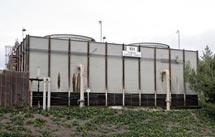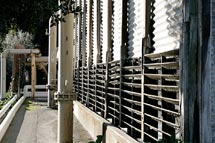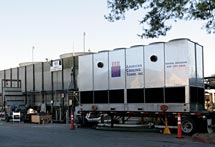
Handy Links
SLAC News Center
SLAC Today
- Subscribe
- Archives: Feb 2006-May 20, 2011
- Archives: May 23, 2011 and later
- Submit Feedback or Story Ideas
- About SLAC Today
SLAC News
Lab News
- Interactions
- Lightsources.org
- ILC NewsLine
- Int'l Science Grid This Week
- Fermilab Today
- Berkeley Lab News
- @brookhaven TODAY
- DOE Pulse
- CERN Courier
- DESY inForm
- US / LHC
SLAC Links
- Emergency
- Safety
- Policy Repository
- Site Entry Form

- Site Maps
- M & O Review
- Computing Status & Calendar
- SLAC Colloquium
- SLACspeak
- SLACspace
- SLAC Logo
- Café Menu
- Flea Market
- Web E-mail
- Marguerite Shuttle
- Discount Commuter Passes
-
Award Reporting Form
- SPIRES
- SciDoc
- Activity Groups
- Library
Stanford
Around the Bay
Tower Turnover
Cooling Tower 101 has stood at the intersection of Loop Road and what is now PEP Ring Road for as long as the SLAC linac has run. A 1966 photo on page 13 of SLAC 1962-2002: Celebrating Forty Years, A Photo History shows the tower's vertically-striped rectangle, a punctuation mark between Buildings 28 and 40 within the newly minted SLAC campus. In the background, a bridge to nothing straddles the linac where Highway 280 will later cross the landscape. Tower 101 has run almost continuously since those days, cooling and circulating nearly 6000 cubic feet of water through a network of chillers, air compressors and low-conductivity water systems for the SLAC Test Lab, Buildings 50, 137 and more.
"This is the last of the original towers," said Facilities Department project manager Harry Shin, who is overseeing replacement of Cooling Tower 101. "We haven't been able to do much maintenance on it because we needed to keep running the chillers." So the old tower has been patched over the years where possible, he said, and has come in need of replacement. "Now's the time."
The work started last week. Before taking down the old tower, contractors are setting up a temporary, trailer-mounted system to take over the cooling load. Then they can shut down Tower 101, drain it and start demolition. The 1960's-era tower comprises a wooden frame with fiberglass panels and louver slats made of a cement and asbestos mix called transite. This material requires special handling; asbestos-trained contractors will remove and bag the transite louvers before the team takes down the rest of the old tower, following an approved demolition plan. Then, after strengthening some of the pilasters and piers that support the structure and upgrading the pump assemblies that circulate tower cooling water, Shin's team will begin to assemble the new, fiberglass tower some time in late February.
Shin traveled to Oklahoma to check the parts for the replacement tower, which shipped to SLAC last week. The new structure uses a fiber reinforced plastic, strengthened by a process called pultrusion. "They gather the glass fibers and pull them into a mold. At the same time they inject the resins, then pull it out—pultrude it—so the fiberglass strands are oriented along the axis of the piece," said Shin, who is a mechanical engineer. The resulting material is strong and doesn't rot or degrade like wood, among other advantages.
"With wooden cooling towers, if you were to get sparks—like a motor let go—the structure could go up very quickly if the fire sprinkler system was not maintained," Shin said. The tower's large cooling fans would boost the flames. In contrast, the new structure's fiber-reinforced plastic is fire resistant, removing the need for a fire suppression system on the tower.
Funding for replacement of Cooling Tower 101 was made available through the Safety and Operational Reliability Improvement Project, or S&ORIP, as a seismic improvement project. Facilities manager Hieu Dao worked closely with Evaristo Valle of the DOE Stanford Site Office to get the project funded as a line item on the federal budget. S&ORIP, which Dao manages, is also the funding source for several other seismic improvement projects, as well as operational reliability projects such as the underground piping replacement. (See "Computing Keeps Its Cool.")
The new tower is expected to reach the "substantially complete" milestone and come online near the end of March. It will undergo full performance testing in July, against the challenge of the summer heat. Strong and resistant, the new guardian of the crossing at Loop and PEP Ring Roads could stand watch for decades to come—even longer than the previous Cooling Tower 101's 40-plus years of service.
Please use caution in the area while the cooling tower project is underway, especially on the walkway between Building 40 and Loop Road. Contact Harry Shin (x 4311) or Jack Fry (x4512) with any questions.
—Shawne Workman
SLAC Today, January 26, 2009


